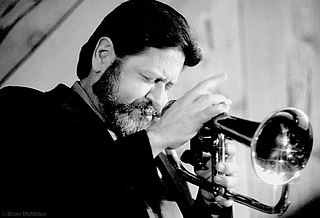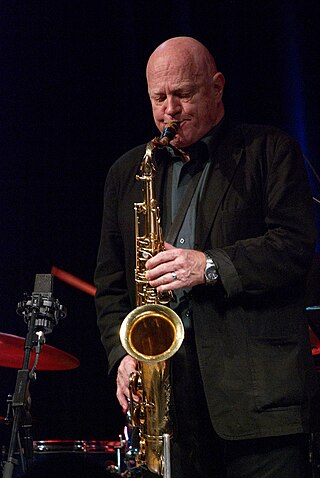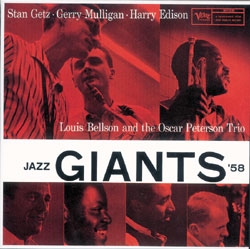Related Research Articles

Frank Wellington Wess was an American jazz saxophonist and flutist. In addition to his extensive solo work, Wess is remembered for his time in Count Basie's band from the early 1950s into the 1960s. Critic Scott Yanow described him as one of the premier proteges of Lester Young, and a leading jazz flutist of his era—using the latter instrument to bring new colors to Basie's music.

Clark Virgil Terry Jr. was an American swing and bebop trumpeter, a pioneer of the flugelhorn in jazz, and a composer and educator.

Harry "Sweets" Edison was an American jazz trumpeter and a member of the Count Basie Orchestra. His most important contribution was as a Hollywood studio musician, whose muted trumpet can be heard backing singers, most notably Frank Sinatra.

Louie Bellson, often seen in sources as Louis Bellson, although he himself preferred the spelling Louie, was an American jazz drummer. He was a composer, arranger, bandleader, and jazz educator, and is credited with pioneering the use of two bass drums.

Robert Philip Militello a.k.a. Bobby M. is an American jazz saxophonist and flautist who was a member of the Dave Brubeck Quartet.
Walter Anthony Murphy Jr. is an American composer, keyboardist, songwriter, and record producer. He is best known for the instrumental "A Fifth of Beethoven", a disco adaptation of Beethoven's Fifth Symphony which topped the charts in 1976 and was featured on the Saturday Night Fever soundtrack in 1977. Further classical-disco fusions followed, such as "Flight '76", "Toccata and Funk in 'D' Minor" "Bolero", and "Mostly Mozart", but were not as successful.
William Thomas "Keter" Betts was an American jazz double bassist.

Terry Gibbs is an American jazz vibraphonist and band leader.

Bobby Shew is an American jazz trumpet and flugelhorn player.
Bob Florence was an American pianist, composer, arranger, and big band leader.
Grant Geissman is an American jazz guitarist and Emmy-nominated composer. He has recorded extensively for several labels since 1976 and played guitar on the theme for Monk and other TV series.

Peter Christlieb is an American musician, playing tenor saxophone in the styles of jazz bebop, West Coast jazz, hard bop and pop music.

Don Menza is an American jazz saxophonist.
Lou Stein was an American jazz pianist.
Eugene Valentino Cherico was an American jazz double-bassist.
Joseph Lucian Roccisano was an American jazz saxophonist and arranger.
Ross Tompkins was an American jazz pianist who was a member of The Tonight Show Band.

Stjepko Gut is a Belgrade-based jazz musician.

Jazz Giants '58 is a 1958 album produced by Norman Granz featuring Stan Getz, Gerry Mulligan and Harry "Sweets" Edison, accompanied by Louis Bellson and the Oscar Peterson trio.
Chiaroscuro Records is a jazz record company and label founded by Hank O'Neal in 1970. The label's name comes from the art term for the use of light and dark in a painting. O'Neal came up with the name via his friend and mentor Eddie Condon, a jazz musician who performed in what were called Chiaroscuro Concerts in the 1930s. O'Neal also got the name from a store that sold only black and white dresses.
References
- 1 2 3 Feather, Leonard; Ira Gitler. The Biographical Encyclopedia of Jazz. Oxford University Press, 2007. ISBN 9780199886401. At Google Books. Retrieved 14 November 2019
- ↑ "N.Y. NARAS Chapter Gives MVP Awards." Billboard, p. 60. 13 November 1982. At Google Books. Retrieved 14 November 2019.
- ↑ "George Young Quartet - Napa Valley Jazz Society". nvjs.org. 2016-10-18. Retrieved 2024-07-13.
- ↑ "Album Reviews". Billboard, p. 14. 6 October 1962. At Google Books. Retrieved 14 November 2019.
- ↑ "George Young - Old Times Album Reviews, Songs & More". AllMusic . Retrieved 7 August 2023.
- ↑ "Salute - Louie Bellson | Credits". AllMusic . Retrieved 7 August 2023.
- ↑ "Walking Man - James Taylor | Credits". AllMusic . Retrieved 7 August 2023.
- ↑ "A Fifth of Beethoven - Walter Murphy | Credit". AllMusic . Retrieved 7 August 2023.
- ↑ "Conquistador - Maynard Ferguson | Credits". AllMusic . Retrieved 7 August 2023.
- ↑ Walter Bishop Jr. Catalog. At Jazzdico.org. Retrieved 14 November 2019.
- ↑ "Sounds...And Stuff Like That!! - Quincy Jones | Songs, Reviews, Credits | AllMusic". AllMusic .
- ↑ Down Beat, Volume 46, p. 30. Maher Publications, 1979. At Google Books. Retrieved 14 November 2019.
- ↑ "Closeup". Billboard, p. 67. 21 April 1979. At Google Books. Retrieved 14 November 2019.
- ↑ Blaney, John. John Lennon: Listen to This Book, p. 321. John Blaney, 2005. ISBN 9780954452810. At Google Books. Retrieved 14 November 2019.
- ↑ Lord, Tom. The Jazz Discography, Volume 33, p. B-173. Lord Music Reference, 2003. ISBN 9781881993162. At Google Books. Retrieved 14 November 2019.